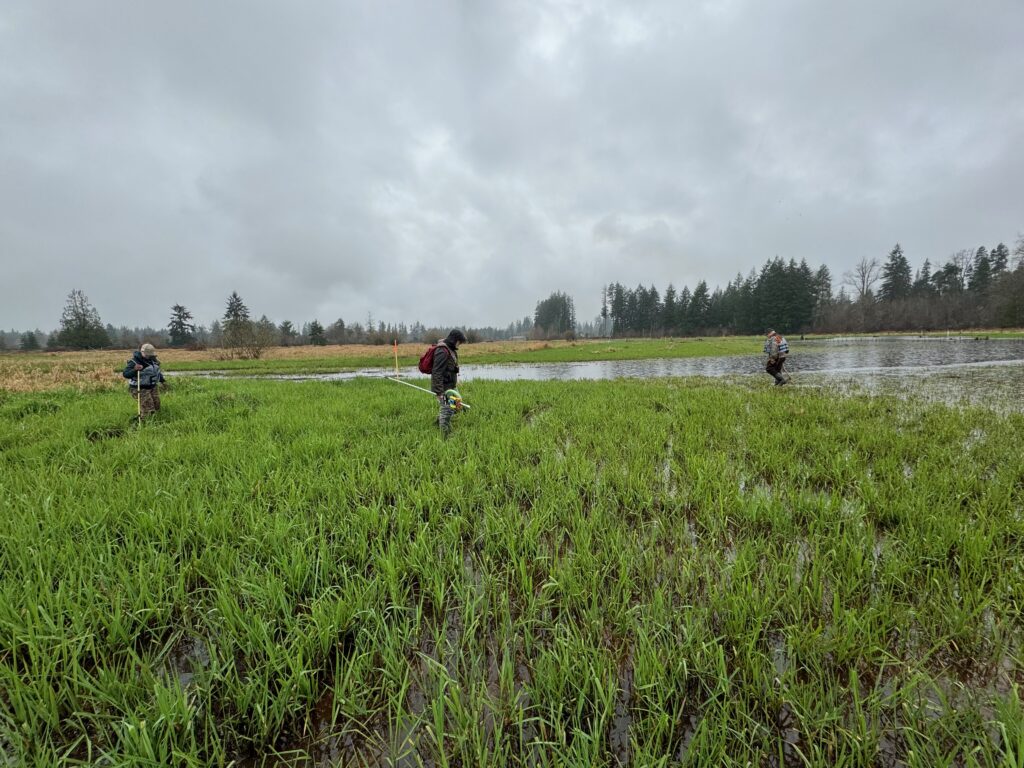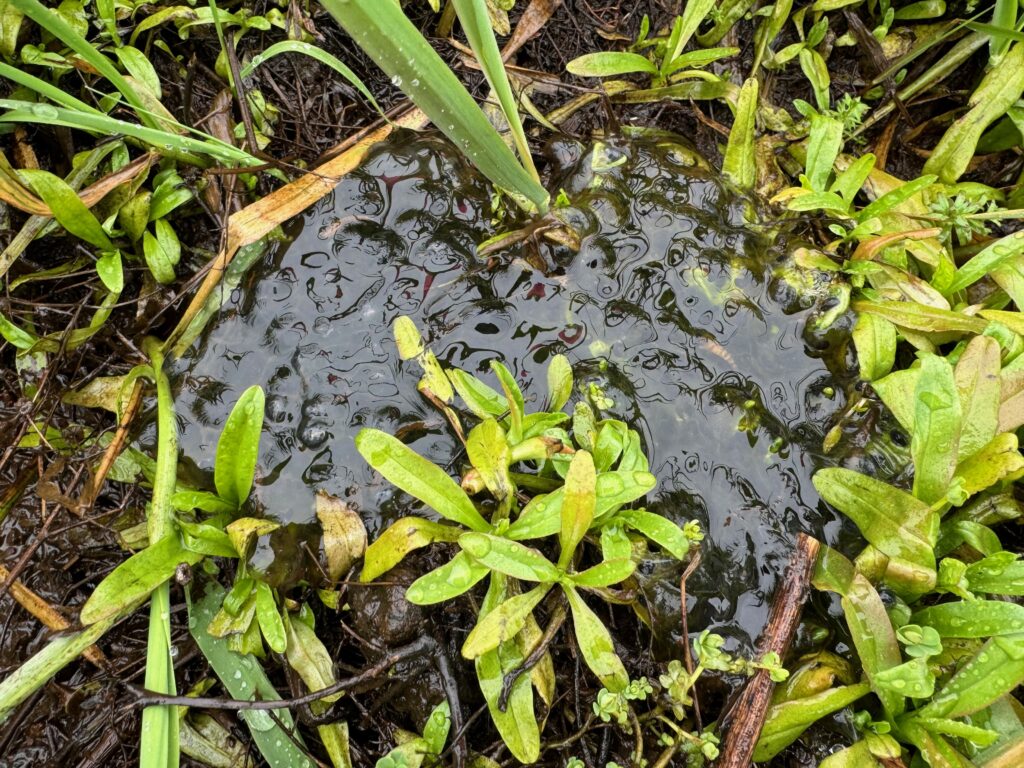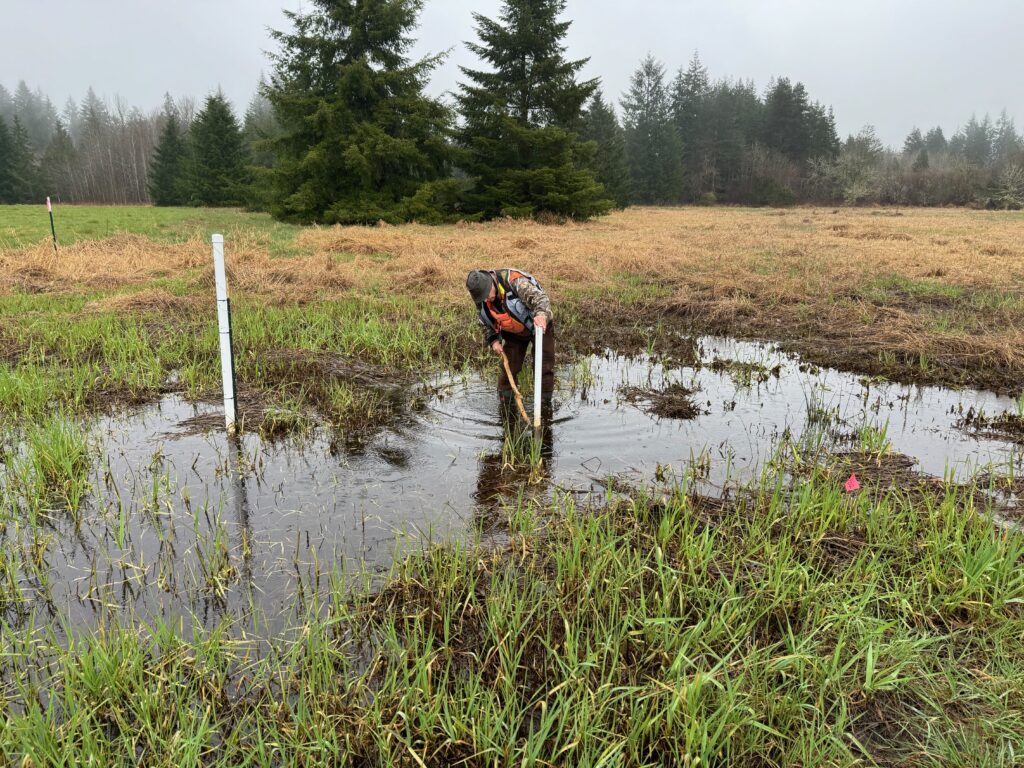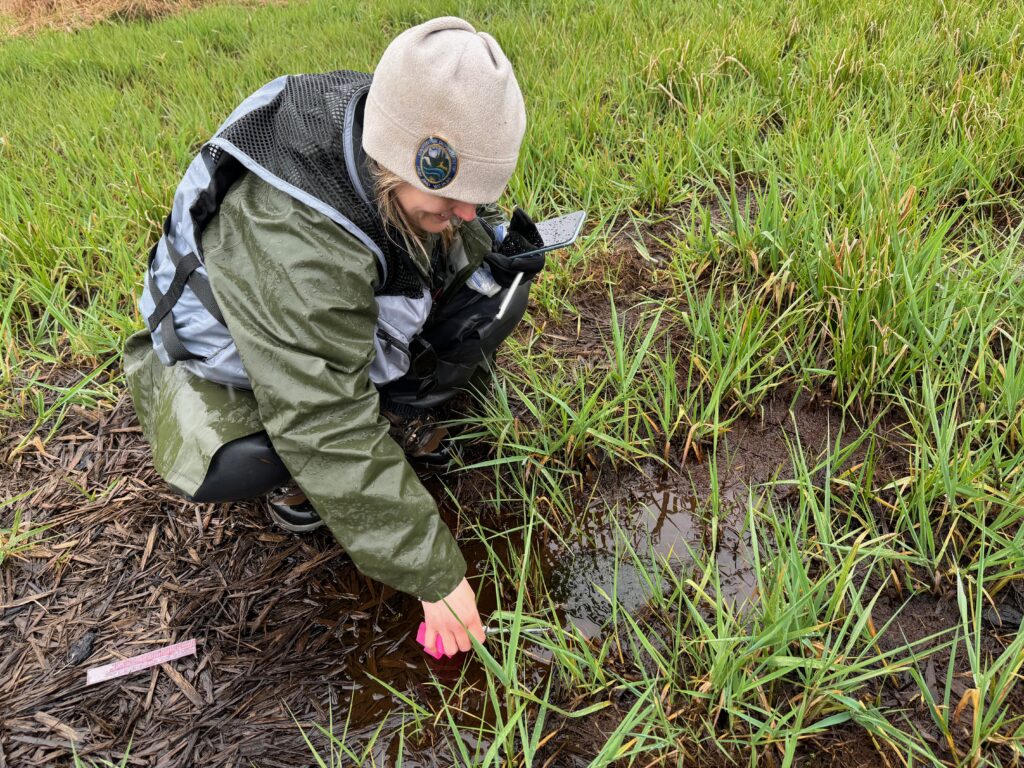As the rain pelts down, drenching an already-marshy landscape, the researchers and Capitol Land Trust (CLT) volunteers gathering at Blooms Preserve hardly notice. Top of their minds is the prospect of discovery, for today’s monitoring expedition promises to reveal whether years of preparation and habitat restoration have paid off in the form of something so small—yet so big!—as frog eggs.
- Washington Department of Fish and Wildlife biologists and CLT volunteers monitor for Oregon spotted frog eggs in Blooms Preserve restoration area. Photo by Liz Burton-Crow.
While awareness of the endangered status of the Oregon spotted frog is growing, what some might not realize is that collaborative efforts to save this amphibious species are ongoing in Washington State, where the Black River watershed is one of the frogs’ few remaining habitats. That’s what makes CLT’s recent addition of 24 shallow ponds to Blooms Preserve so important to their recovery, reversing habitat loss while providing ideal conditions for successful egg laying.
- 24 ponds were dug in the summer of 2023. This shows them in May 2024. Photo by CLT.
The frogs’ timing when it comes to depositing eggs is equally important, with Oregon spotted frogs typically laying clusters in February and March. “Too early,” Washington Department of Fish and Wildlife (WDFW) wildlife biologist Emily Butler explains, “and the eggs are at risk of damage from frost.” What’s more, water temperature impacts the speed of egg development, with those in colder water taking longer to mature into tadpoles.
- Oregon spotted frog egg cluster. Photo by Liz Burton-Crow.
Eggs deposited later in the season face a different danger: stranding away from deeper waterways or worse yet, drying up completely. “Today’s rain might be a lifesaver,” observes long-time CLT volunteer Tom Terry. “The tadpoles need time to swim to the channel,” he adds, gesturing towards Blooms Ditch.
- Tom measures the water level in Oregon spotted frog habitat. Photo by Liz Burton-Crow.
There, efforts to save the Oregon spotted frog are not limited to humans. They also include nature’s lumberjacks, the beavers, who “have a nice relationship with the frogs,” Tom says, smiling. “I would guess this water is about a foot deeper than it would be without the beaver dam that’s here.” The beaver dam buys the tadpoles precious time to reach the canal before shallower waters dry up. What’s more, as beavers move through this aquatic habitat, they create channels linking shallow wetland areas with larger waterways, which also aids the passage of vulnerable tadpoles.
- Evidence of beavers on a willow stake. Photo by CLT.
Thanks in no small part to symbiotic species like the beavers along with the efforts of organizations like CLT and its powerful like-minded partners, these days this former hayfield is looking more and more like the expansive wetland it was about a hundred years ago before it was drained for agricultural irrigation. Signs of the Oregon spotted frogs have returned along with the wetlands, their egg masses recorded near this site for the past several years, however many if not all of these were laid far from the heart of the preserve and away from deep-enough water channels.
This year, things are different.
There is evidence that CLT’s active habitat restoration efforts are paying off, with two egg clusters appearing to belong to Oregon spotted frogs already spotted just north of the beaver dam. Today’s monitoring mission is the best chance so far to spot egg clusters within the restoration area that will give them the best chance of hatching and long-term survival.
It doesn’t take long for Emily’s well-trained wildlife biologist gaze to spot the first eggs appearing to belong to the endangered frog in question. Soon after, a second egg mass is discovered, then a third! Before the day is over, six potential Oregon spotted frog egg masses are identified in the newly restored habitat at Blooms Preserve, a rare and welcome find in a place so critical for their recovery.
- Washington Department of Fish and Wildlife biologist Emily Butler takes temperature data from an Oregon spotted frog egg mass. Photo by Liz Burton-Crow.
Yet there is one more thing that needs doing before the day’s mission can be declared a success. Four egg masses are far enough from the ponds that Emily and her colleague from WDFW decide to move them closer to ensure their best chances for survival. This can be particularly tricky, given that the eggs appear to be in several stages of development, with some even close to hatching. But working together, slowly and steadily, the two WDFW scientists transfer these eggs to an ideal spot they’d identified closer to deep waters, though not too deep as to be negatively affected by the surrounding water temperature.
- Biologist carefully moves an Oregon spotted frog egg mass. Photo by Liz Burton-Crow
In addition to data on water temperature and depth, Emily collects samples for genetic testing that can confirm these eggs indeed belong to Oregon spotted frogs. Due to a backlog at the WDFW’s in-house lab, the results of these tests can take upwards of a year. In the meantime, she plans to continue monitoring the site every 7-10 days throughout the frogs’ breeding season. “If you wait too long,” Emily warns, “they will all hatch out and what remains just looks like a flattened pancake.”
- Emily collecting genetic samples from an Oregon spotted frog egg mass. Photo by Liz Burton Crow.
Incredibly, the monumental habitat restoration effort undertaken at Blooms Preserve and the potential comeback of the Oregon spotted frog represents just a fraction of CLT’s conservation efforts, with more than 100 properties protected in the hope that local biodiversity can live and thrive as much as these steadfast frogs have. Every acre of land preserved by CLT is made possible by donors, whose generous contributions conserve healthy ecosystems that will support species like the Oregon spotted frog for generations to come. Consider making a gift of any size today!









